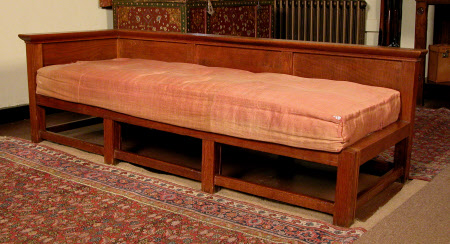Daybed
Rudyard Kipling (1865 - 1936)
Category
Furniture
Date
circa 1902
Materials
Oak, horsehair, silk
Measurements
59 x 183 x 72 cm
Place of origin
England
Order this imageCollection
Bateman's, East Sussex
NT 760885
Summary
An oak daybed, English, circa 1902, designed by Rudyard Kipling (1865-1936) and made by Leslie Cope Cornford (1867-1927). The panelled back and single end with broad capping rail above a seat fitted with a horsehair mattress covered in peach silk tapestry. Raised on eight square-section legs joined by foot stretchers.
Full description
This daybed was designed by Rudyard Kipling for his study at Bateman's in 1902, the year in which he and his wife moved to the property from their former residence, The Elms in Rottingdean, Sussex. Kipling, who had sourced some suitable oak, had originally asked Leslie Cope Cornford (1867-1927), architect-turned journalist, naval correspondent and writer - and, according to Lycett, Kipling's biographer, 'an excellent carpenter' - to design him a couch because 'The old thing from the Elms is a blister and an offence and besides I want something bigger and broader.' Leslie's original idea was dismissed because, Kipling wrote, 'Who am I to have monograms and gilding and pink morocco? It is too gorgeous.' He then made his own rough sketch of the couch he wanted - something with a broad toprail for books and pipes and two open sides. He was delighted when the couch arrived in time for Christmas 1902 and wrote 'It's a great - an unqualified success! C. [Kipling's wife, Caroline] is lying down on it even now...It is perniciously lazy and I have been wallowing on it all this afternoon. Best of all it suits the room to a hair, in tone, texture and temper' [Macdonald, pp. 143-4. Letter RK to LCC, 1902]. Kipling's daughter, Elsie, would later recall that he would lie on this daybed often, smoking and waiting for inspiration. When it came he would jump up, 'go to the desk, write a line or two, make a note or a correction, then resume his place on the sofa' [Lycett]. It is interesting that this daybed, one of the only pieces of 'modern' furniture at Bateman's, otherwise furnished in a heavy, antiquarian style, was designed by Kipling himself. NT 761462, a photograph in the National Trust's collections, of Rudyard Kipling in his Study at Bateman's circa 1930, shows this day-bed in the background.
Provenance
Listed in Mr. Kipling's Work Room in the inventory taken at Bateman's in 1939. Bequeathed by Caroline Starr Balestier, Mrs Rudyard Kipling (1862-1939) with Bateman’s and its contents.
Makers and roles
Rudyard Kipling (1865 - 1936), designer Leslie Cope Cornford (1867 - 1927), maker
References
Lycett 2015: Andrew Lycett, Rudyard Kipling, 2015 Macdonald 1999: Meryl Macdonald, The Long Trail: Kipling Round the World, Tideway, 1999, pp. 143-4
